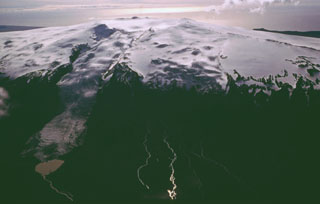Report on Eyjafjallajokull (Iceland) — 9 June-15 June 2010
Smithsonian Institution / US Geological Survey
Weekly Volcanic Activity Report, 9 June-15 June 2010
Managing Editor: Sally Sennert.
Please cite this report as:
Global Volcanism Program, 2010. Report on Eyjafjallajokull (Iceland) (Sennert, S, ed.). Weekly Volcanic Activity Report, 9 June-15 June 2010. Smithsonian Institution and US Geological Survey.
Eyjafjallajokull
Iceland
63.633°N, 19.633°W; summit elev. 1651 m
All times are local (unless otherwise noted)
The Nordic Volcanological Center (NVC) at the Institute of Earth Sciences reported that on 9 June rumbling noises were heard at Gígjökull just before a steam cloud rose from the summit crater. The crater area was not visible the next day, but a few small shallow earthquakes beneath the summit crater continued to be detected. On 11 June white steam was mainly confined to the crater, but occasionally a steam plume rose higher than the rim. Heavy rainfall during the previous few days led to flooding along the Svadbaelisa River. The water contained a large amount of mud and flowed over levees into fields. NVC also noted that a lake about 300 m in diameter had formed in the large summit crater. Steam rose as high as 1 km from the rims, especially from the N side. Two small vents above the water level on the W side emitted brown-colored clouds.
Geological Summary. Eyjafjallajökull (also known as Eyjafjöll) is located west of Katla volcano. It consists of an elongated ice-covered stratovolcano with a 2.5-km-wide summit caldera. Fissure-fed lava flows occur on both the E and W flanks, but are more prominent on the western side. Although the volcano has erupted during historical time, it has been less active than other volcanoes of Iceland's eastern volcanic zone, and relatively few Holocene lava flows are known. An intrusion beneath the S flank from July-December 1999 was accompanied by increased seismic activity. The last historical activity prior to an eruption in 2010 produced intermediate-to-silicic tephra from the central caldera during December 1821 to January 1823.
Source: Institute of Earth Sciences

